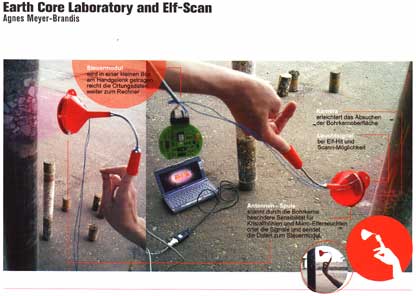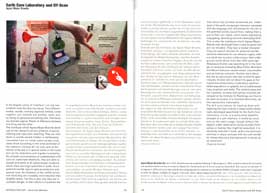
In the English notion of
'interface' not only two surfaces meet but also two faces. Two different
bodies, worlds, normally separate entities, come together, turn towards
one another, mesh, and by doing so generate something else. Interfaces
are dramatic places. Places of difference between one thing and the other.
The interfaces which Agnes Meyer-Brandis develops on her research raft
are artefacts of secret listening and voyeuristic watching. They are interfaces
to worlds usually hidden or deliberately concealed from us: lovely subterranean
coral reefs which according to the artist and head of the research institute
do not only exist at the bottom of the sea or in special caves on the
coast, but can be ubiquitous and migrate incessantly. As nomadic accumulations
of coelenterates with calcium carbonate skeletons, they are able to spread
and settle at all subterranean locations where there are large quantities
of water. Such potential worlds require special protection and special
care. As shadows of the visible terrestrial world they are incredibly
more beautiful than tangible reality. Yet this is also why they are in
constant danger. In their efforts to humanize the little which has not
been humanized yet, inhabitants of the earth increasingly intervene –
equipped with the language and instruments for the job – in the
potential worlds around them, making them a part of their own reality,
which means oppressing, subjugating, absorbing and even destroying them.
This is why the interfaces which Agnes Meyer-Brandis has developed have
a special grace and are not intruders. They have a medial character. They
are search devices for potential worlds, sensitive extensions for our
sensory organs, without which the mundus subterraneus – that underground
world which more than 350 years ago Athanasius Kircher was searching for
in the triangle of volcanoes formed by Mount Etna, Stromboli and Mount
Vesuvius – would remain inaccessible and so entirely unknown. Kircher
went about this like an astronomer who has turned his gaze inwards. Kircher
did not direct his gaze at the mysterious phenomena of planetary systems,
stellar populations or galaxies, but at subterranean fires, eruptions
and shifts. The stethoscopes and ear trumpets, screens and optical channels
developed at the Institute for Reefology are thus to be seen as probes
of a reversed astronomy, as fine mareonomic instruments.
The core-sample scanner for tracking down and exploring the lives of elves
in these subterranean reefs, developed specifically for the Earth Core
Laboratory in Linz, is a particularly beautiful example of a soft interface.
It works by touch only on the user’s page, though without the objects
under observation being touched themselves or feeling they might be assaulted;
it is extremely reduced in scale, quite inconspicuous, and thus in sharp
contrast with the lush worlds for whose discovery and exploration it serves
as an instrument.
(Siegfried Zielinski)
